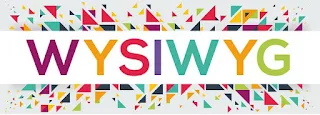WYSIWYG is an acronym for "What You See Is What You Get". WYSIWYG is a type of word editing program which enables users to view and edit a document in the precise way it would appear in other formats, either in a softcopy or hardcopy form, i.e., in web page presentations, sliders or prints.
It infers that a user should not expect anything of extra value, other than what is actually presented as a product or service.
WYSIWYG, an acronym for "What You See Is What You Get," is a term widely used in the realm of technology and design. It refers to a system or interface that allows users to view and edit content exactly as it will appear in its final form. In this article, we will explore the concept of WYSIWYG, its historical development, applications in different fields, and its future trends.
To grasp the essence of WYSIWYG, it is crucial to comprehend what the term represents. WYSIWYG enables users to visualize the end result of their work in real time, eliminating the need for complex coding or technical knowledge. By providing a direct representation of the final output, WYSIWYG empowers individuals to create and edit content intuitively.
Historical Development of WYSIWYG
The roots of WYSIWYG can be traced back to the early attempts at simplifying the process of content creation. We will delve into the historical milestones that paved the way for the widespread adoption of WYSIWYG, along with its impact on digital publishing and design practices.
WYSIWYG in Text Editors and Word Processors
One of the primary applications of WYSIWYG is in text editing and word processing. We will explore how WYSIWYG revolutionized the way we interact with text editors, the features and benefits it offers, and highlight popular word processors that incorporate WYSIWYG functionality.
WYSIWYG in Web Design
In the world of web design, WYSIWYG editors have become instrumental in simplifying the creation of websites. We will discuss the specific tools and platforms that enable designers to visually construct webpages, and examine the advantages and limitations of utilizing WYSIWYG in this context.
WYSIWYG in Graphic Design
The influence of WYSIWYG extends to the realm of graphic design, where it has transformed the creative process. We will explore how graphic design software integrates WYSIWYG functionality, empowering designers to visualize their creations in real time and enhancing their productivity.
WYSIWYG in Email and Document Creation
The convenience of WYSIWYG is not limited to web and graphic design but also extends to email and document creation. We will discuss how WYSIWYG is incorporated into email clients, newsletter editors, and document creation tools, streamlining the process and ensuring consistent output.
Limitations and Challenges of WYSIWYG
While WYSIWYG offers significant advantages, it is not without limitations and challenges. We will examine potential issues with rendering and compatibility, the learning curve associated with WYSIWYG tools, and the delicate balance between creative freedom and the constraints of WYSIWYG environments.
Trends and Innovations in WYSIWYG
As technology continues to advance, so does the potential of WYSIWYG. We will explore the future trends and innovations in WYSIWYG, including advancements in the technology itself, the integration of artificial intelligence and automation, and the potential impact on various industries and user experiences.
In conclusion, WYSIWYG has revolutionized the way we create and interact with content across various domains. Its ability to provide a visual representation of the final output has empowered individuals and transformed creative processes. While it has its limitations, the future of WYSIWYG holds promising advancements that will shape the way we design, communicate, and create content.

